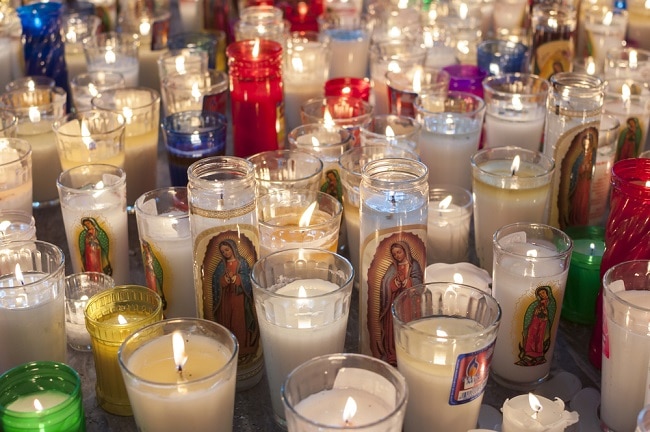- Introduction to Beliefs and Superstitions in Mexico
- Lighting Candles to Saints and Virgins
- Finding a Husband
- Amarres
- The Pilgrimage of December 12th
- Day of Saint Jude Thaddeus
- Pyramids of Teotihuacan
- Catemaco
- Witchcraft in Catemaco, Mexico
- Food and Drink Superstitions in Mexico
- What to Eat for Good Luck
- Physical Rituals for New Year
- La Llorona
- The Curse of Cruz Azul
Introduction to Beliefs and Superstitions in Mexico
By: Charles Black
Now let’s turn to superstition in Mexico. In this introductory guide we will take a look on how people of Mexico get lucky and unlucky. It all happens through charms or amulets, rituals, folk tales, special dates and locations, food or even sports.
Let’s take a look, shall we?
Lighting Candles to Saints and Virgins
Mexico, like most countries in Latin America, is a society where religion plays a big role in everyday life.
The many impressive churches and cathedrals spread around the country’s old colonial cities, and the fervor with which Papal visits are followed and attended are cherished by the inhabitants of the country.
Catholicism, with its wide array of saints and virgins, is in general a fact of life across the social ladder.
One common practice is to light a veladora (a thick candle inside a container) in honor of a saint or a virgin, with the intention of asking him or her for a favor.
The container itself can vary in craftsmanship and materials. Sometimes it is a highly decorated blown glass and other times only a little more than a simple plastic cup.

Once lit, the veladora is placed to burn out uninterruptedly in an altar to the chosen Saint.
Although in cases where space of resources do not permit the fitting of an altar, it is also acceptable to have the container itself depict the image of the chosen patron.
Different religious figures have different favours and properties associated with them.
Saint Jude Thaddeus, for example, is overwhelmingly popular within the lower classes. He is a patron of those facing hardship or who have lost their way.
The Virgin of Guadalupe is thought to grant good luck and good health.
Finding a Husband
Saint Anthony is thought to help unmarried women find a husband. A statuette or other representation of him is placed upside down by a candle.
As the humorous popular belief goes, the irritation it causes him to be in such an uncomfortable position is what does the trick.
The lone maiden is supposed to repay his favour by putting him upright once a partner has been found.
This particular belief has even entered popular culture amongst the non-religious. The foreveralone crowd often allude to him in a joking manner.
Amarres

An amarre, from the verb amarrar, literally meaning ‘to tie up’.
In this context also understood as ‘to help something set in’. It is a popular folkloric belief in Mexican society.
A wide variety of them exist. In general, an amarre is a kind of ritual/spell believed to precipitate a desired outcome in one area of life or another.
The most widely known among them are amarres de amor or love tie-ups.
As one might guess from the name, these are rituals intended to make another person develop feelings of love, desire, and fidelity towards the caster.
The specific ingredients and procedures vary between the many schools of esoteric thought.
The most common ones usually involve candles; red and white, symbolising love and purity, respectively.
Also needed are photos of the caster and the one they love, thread, and occasionally a spice, usually cinnamon or honey.
In its most basic form, an amarre is executed as follows: The photos are tied together with red thread, the candles are sprinkled or doused with the spice and then lit, and an incantation is pronounced.
Once the candles have burnt out completely, the spell is thought to be completed. The caster then just waits with open arms for the one they have charmed to come to them.
Not all types of amarres concern love. Many others are thought to help with anything from health problems, to financial difficulties, to the attainment of success in career and business.
SPECIAL DATES in MEXICO
The Pilgrimage of December 12th

Virgin Mary giving roses to
Juan Diego on the
chapel wall on Tepeyac Hill
The Virgin of Guadalupe is one of the most important figures in Mexico’s brand of Catholicism.
She is a cultural touchstone which often transcends social and geographical divisions.
As the legend goes, she first appeared to the humble native Juan Diego.
He was made into a saint by Pope John Paul II- atop a hill in the northern part of the current territory of Mexico City. She left her image etched on his cloak for all to see.
The impressive Basilica of Our Lady Guadalupe is located on the spot where the apparition allegedly occurred.
It is Mexico’s largest shrine and a point of reference for Catholics all across the country.
The general area is known as Villa de Guadalupe, or more colloquially, La Villa.

In addition to the honouring and acknowledgement she receives year-round, the Virgin of Guadalupe has a special day all to herself on the 12 of December.
Large scale celebrations occur on that day. Fireworks can be heard late into the night in just about any part of Mexico City.
The pilgrimage
A key component of the celebrations is known as el peregrinaje or the pilgrimage. This is when tens of thousands of people from all over the country flock to La Villa in a show of faith and devotion, either by car, or by bus.
In some more extreme cases, many walk in caravans, which can mean beginning the pilgrimage days or weeks in advance.
They do whatever it takes to be there on time for the Grand Mass held on the morning of the 12th.
The Virgin of Guadalupe is believed to grant favour, health, happiness and good luck.
The people who undertake the pilgrimage see the inconveniences it implies, -which can include camping on the streets for those unable to find or afford accommodation- as a small price to pay.
On a somewhat less pious note, the Dia de la Virgen is also held to be the unofficial start of the party season encompassing the Christmas Holidays.
This occurs in the period between December 12 and January 6. The many parties, gatherings and celebrations are universally known as The Guadalupe-Reyes Marathon.
Overindulgence in food and alcohol is very common. Mexico City police presence in the street multiplies exponentially.
Day of Saint Jude Thaddeus

As previously mentioned, Saint Jude Thaddeus, popularly known as San Juditas is by far the most popular figure religious among the lower classes of Mexico City.
He is believed to be the patron saint of lost causes.
This makes him a key figure amongst disenfranchised youth in the city who choose to turn to a life of petty crime.
They have become a rather maligned stereotype amongst the more law-abiding denizens of the city. This is because of their choice of attire, slang, and customs.
Their most common crimes include everything from pickpocketing and public intoxication. Crimes may also exceed to outright armed robbery, assault and small-scale drug commercialization.
Celebrating Saint Jude
Chief among their beliefs is loudly and openly celebrating the day of their patron Saint. This is accomplished by flocking to the small church consecrated to him carrying an effigy or statue of the Saint.
It can range anywhere from action figure-sized to over a metre tall. They also bring flowers or other offerings, all of which are then deposited in the chapel.
The church’s location, within the confines of the city’s historic centre, in combination with the fact that most of Saint Jude’s worshippers come from the less well-off fringes of the metropolitan area.
This makes for a perfect storm of chaotic oversaturation in the city’s already perpetually congested public transport systems. That is of course before even factoring in the people-sized statues in their arms.
A visit to Saint Jude’s church on the 28th day of every month is habitual among worshippers.
October 28th – Feast Day of Saint Jude
The occasion expands significantly in October. Celebrations include fireworks. Large groups of people result in the outright closing of streets by those who seek the saint’s favors.
All pursuing to improve their livelihood and attaining their goals.
The most cynical crowd quite literally ask San Juditas to aid them in the commission of their crimes and the subsequent evasion of the authorities.
Inversely, for those not engaged in the worship of Saint Jude but who happen to live in the areas surrounding the gathering, an opposite ritual to avoid bad luck has developed.
They try to avoid leaving their residences if at all possible so they can hold on to their phones and wallets.
SPECIAL LOCATIONS in MEXICO
Pyramids of Teotihuacan
The ancient city of Teotihuacan is one of the most marvellous, best preserved archeologic sites of pre-columbine Mesoamerican civilisation.
Its convenient location is just north of Mexico City. It is easily accessible by car and bus.
The ancestral home of the multi-ethnic Teotihuacans one is of the country’s most popular sites for tourists both local and international.
On one particular day of the year, though, hopeful visitors can expect to find significantly more difficulty –and longer queues! – navigating their way to and through the site. We’re talking about the 21st of March, the day of the spring equinox.
Teotihuacan is famous especially for its two stone pyramids: The larger Pyramid of the Sun and the somewhat smaller Pyramid of the Moon.
They are located on opposite sides of a long footpath known as The Avenue of The Dead
The megalithic structures are the site’s main attraction. Tourists climb to their summits through the steep central staircases, which are believed to have led to altars long since lost to the ravages of time.

The Power of Spring Equinox
Like in many archaeological sites across Mesoamerica, the location of the pyramids was decided based on astronomical factors. This takes on a special significance on the day of the spring Equinox.
Thousands of people attend a ritual based on ancient indigenous beliefs, which consists of climbing to the summit of the Pyramid of the Sun in or around noon.
Their goal is to ‘take’ energy from the sun itself, whom many indigenous cultures considered to be a deity.
The taking of energy is accomplished by standing on the summit with arms aloft. The energy of the intense spring sun of Mexico is said to recharge the receiver, allowing him or her to feel healthy and energised for the rest of the year.
Catemaco
The state of Veracruz, located in the coast of the Gulf of Mexico, has many particularities.
One could talk, for example, about virgin, non-commercialised beaches, large commercial ports and military shipyards, delicious fish-based cuisine, or even the state’s ethnically unique population.
Veracruz is one of the few places in the country where black Mexicans, descendants of slaves brought in during colonial times, can be regularly spotted.
But for our purposes, the real attraction of the state lies in the city of Catemaco, named after the lake on whose shore it rests. It is a moderately popular attraction for general touristic endeavours.
Its crystalline lake, ideal for fishing or water sports is its main draw. Many examples of early colonial architecture abound in the city.
The surrounding rainforest presents opportunities for hiking, camping and nature watching.
Witchcraft in Catemaco, Mexico
An entirely different attraction, though, is the city’s countrywide reputation as a centre for the practise of witchcraft.
The Brujos de Catemaco, a loosely associated group of predominantly male witches for hire, are known for engaging in a variety of rituals.
Theoretically harmless white magic, such as limpias (cleansings) is performed with a variety of herbs and incenses, alleged to help the client rid him or herself of bad influences and spirits affecting their daily life.
The much more insidious black magic engages in things such as animal sacrifice and spiritual summonings.
The latter, much more tabloid-friendly practise, has given Catemaco a status of infamy throughout the country.
More conservative, Catholic sectors of the population look down on them as heretics and charlatans.
The Brujos, however, argue that the rituals they undertake follow indigenous traditions from long before colonial times.
These were then enriched and augmented through syncretism when the local population came in contact with Catholicism, brought by the Spaniards, and West African religions brought by slaves. This would become the basis of voodoo.
The Commercial Aspect of Witchcraft in Catemaco
Witchcraft in Catemaco has taken on a very commercial visage, with many Brujos advertising their services online.
Events held throughout the year are attended by thousands of people. They are open not only to those who believe in magic, but also to curious, adventurous explorers.
A unique aspect of Catemaco witchcraft is the fact that, unlike many similar practises, it is not confined to the poorer sectors of society.
In fact, many powerful figures, from celebrities, to businessmen and even politicians, have been alleged to retain the services of the Brujos.
Food and Drink Superstitions in Mexico
We know New Year’s Eve to be a very ritualised date all across the world. A time of new beginnings, new opportunities, big hopes and big plans and all that.
Mexico is no exception to this, of course, but the country does possess its fair share of ritualistic quirks, many of them associated with food or everyday items.
Unlike many other countries, where Christmas is the family holiday with a big dinner and New Year’s Eve is the party night, in Mexico it is not uncommon for the 31st of December to also be a night spent with the family and friends.
Once again this evening includes a large banquet, which is not to be consumed until the stroke of midnight, where amongst the most superstitious, chaos ensues.
What to Eat for Good Luck
First there are the grapes. Twelve seedless green grapes are delicately enveloped on a serviette and placed on every seat at the dinner table.
On the stroke of midnight, before popping the bubbly, be it champagne, cider or recently the ever-more-popular Prosecco, each guest consumes the grapes one by one.
The grapes are numbered to represent the twelve months of the year and the twelve strokes of the bell. Their consumption is associated to the person’s new year’s resolutions.
One grape equals one resolution or purpose. Some people spend many days in advance of the big dinner mapping out what their resolutions will be.
They will then recite them internally whilst chewing each individual grape.
Next up is a small bowl of lentils, often accompanied by a few slices of lightly fried plantain.
Consumed even quicker than the grapes, the colouring of the bowl’s contents is supposed to represent gold. Devouring them is believed to augur good financial prospects.
Some people wrap it up there and proceed to engage in the traditional sparkling toasts. Others follows it up with more physical rituals.
Physical Rituals for New Year
Taking an empty suitcase and strolling a short distance away from one’s threshold before circling back inside.
This is believed to enhance one’s opportunities of travelling throughout the upcoming year.
Quickly sweeping around the house with the aid of a broom, always aiming towards the outside, is believed to help drive away any bad influences or spirits that might otherwise affect the household owner’s ability to achieve his or her resolutions.
Believers stand outside their house holding a fistful of coins.
The coins are thrown backwards into the house much like a newlywed bride would throw her bouquet. This is once again believed to attract money into one’s life.
And of course, no Mexican ritual would be complete without candles. Twelve, this time, of varying colours, and are often sprinkled with spices and grains. These are set alight and allowed to burn out throughout the night.
Each individual coloured candle believed to attract a different sort of positive outcome to the enterprises to be undertaken in the New Year.
Clothes and Underwear for New Year

Finally, there is also the kind of ritual that is worn. Namely, it is considered good luck to wear an entirely new outfit for the occasion.
Wearing new clothes is supposed to increase the chances of amassing further material possessions.
Finally, popular both in earnest and in a tongue-in-cheek fashion, the wearing of underwear of certain colours – red to attract love or yellow to attract even more money- is also a common custom.
Many otherwise non-superstitious people engage in it, since ideally no one will be able to tell.
And if someone ends up seeing one’s red underwear that night, well, it would follow the spell was not so bogus after all.
POPULAR SUPERSTITIONS IN MEXICO
La Llorona
La Llorona, or the crying lady, from the verb llorar, meaning ‘to cry’, is definitely among Mexico’s best known folk tales.
Originating in late colonial times, the legend speaks of a woman who is heartbroken after being either abandoned by her husband or widowed, depending on who is telling the story.
She went insane and drowned her infant children.
Upon coming to her senses and realising the horrific deed she had committed. She then killed herself out of shame.
Unfortunately she was denied entry into heaven due to her heinous sin, and was condemned to wander the earth as a wraith.
Her spirit is said to appear after midnight. Wearing a limpid white dress and dragging heavy chains which rattle on the ground as she glides, she is said to wander around all of Mexico.
She is desperate to be reunited with her children. In tune with this, she loudly wails out “Ay, mis hijos” (oh, my children) as she traverses the empty streets.
Beware of La Llorona
As common superstition goes, anyone who runs into her on the street after a night of debauchery will be swiftly killed by the vengeful spectre.
Even the mere act of gazing upon her from a window is supposed to be an omen of bad luck and suffering for the rest of the beholder’s life.
More extreme additions include her trying out the many doors she encounters in her nightly penance walks.
Whereupon finding an unlocked threshold she will proceed to enter the house and murder any children present in the household.
The adults are spared so they can share in the suffering of being left childless.
In a more lighthearted tone, the legend of La Llorona has long since been given a positive spin by parents across Mexico.
They use her to ensure the obedience of their offspring.
This often includes matters such as respecting an agreed-upon curfew or going to bed at a reasonable hour.
The Curse of Cruz Azul
And to finish up on a more humorous note, we have got the sad, sad story of Cruz Azul.
Just like in many European countries, football is one of Mexico’s biggest passions.
Many of the clubs playing in the country’s top flight having a following numbering in the millions, not only in the country’s territory, but even across the border in the United States, where many Mexican nationals keep up with their club’s fortunes.
One club of such popularity is Cruz Azul (blue cross), named after the cement company which initially sponsored its formation. The club plays its home matches in the country’s Capital.
It the most popular and historically successful in the League. Cruz Azul dominated the League for much of the 70s and 80s.
Cruz Azul – The Almost Club
Since last winning the league in 1997, though, Cruz Azul has come to be known as the almost club.
The club has become the outright laughing stock in the League. This due to its tendency to reach a large amount of finals without ever winning the title again.
This has included chronic bottling of seemingly surefire wins time and time again. A most painful event was against their biggest rivals, Club America, in 2013.
Cruz Azul went on to blow a 3-0 home advantage to lose 4-3 after extra time, to an injury time goal from the opposing goalkeeper, no less.
Incidents such as this have given way to the commonly held belief that the club is cursed.
This a belief which has extended so far and wide in popular culture that it led to coining of the verb Cruzazulear, meaning to fail at the last possible minute in an endeavour which seemed to be succeeding.
The Unlucky Cruz Azul Jersey
Thus, the club’s jersey has become a common ‘curse’ item in Mexico’s collective imaginarium.
Wearing it, touching it or even being near it is seen as a surefire augur of bad luck and failure, with many people using the dreaded kit in humorous attempts to sabotage their enemies.
The most recent examples? Presidential candidate Ricardo Anaya, at one point neck and neck with eventual winner Andres Manuel Lopez Obrador, was photographed shaking hands with a man wearing the blue jersey at a campaign rally.
Merely a couple days later, he was involved in a money laundering scandal which led to him losing the election by a margin of 2/1.
And for those of you intent on attending the next World Cup, be very wary of Mexican fans.
On the eve of the match between Germany and Mexico in Moscow, a contingent of German fans were photographed receiving a Cruz Azul jersey as a ‘goodwill’ gesture from a Mexican fan.
Well, we all know how that turned out.
Written by: Charles Black

Superstitions in Uganda

Indian Superstitions when Moving into a New House

Irish Folklore

Superstition in Thailand

Superstition in Mexico Introductory Guide

Indian Dressing Customs

Meal Superstitions in India

Rituals in Kenya

Wedding Customs in India

Thailand – Land of Spellbinding Superstitions and Bewitching Beliefs

Diwali Superstitions

Superstitious Uganda

DRINKING CUSTOMS IN INDIA

Indian Superstitions When Visiting

Indian Pregnancy Superstitions

Top 10 Superstitious Festivals in India

Superstitions in India

